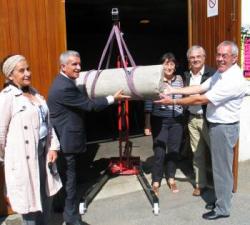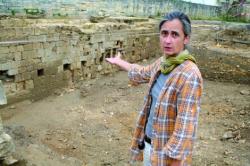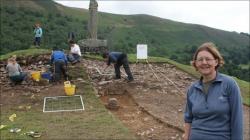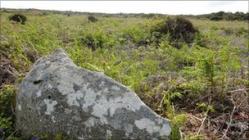- 03 - 04 SEPTEMBRE
- INDI-UNI : ANTHROPOLOGIE - ARCHEOLOGIE
INSCRIPTION 2011 – 2012 COURS A DISTANCE
REGISTRATION 2011 – 2012 ONLINE COURSES
- FRANCE –  Lortet - Les vestiges de Lortet ne s'arrêtent pas à la préhistoire. Lors d'une entrevue entre le maire de Tarbes Gérard Trémège et de Lortet Michel Sicard, celui-ci lui fait part d'une borne exposée au musée Massey à Tarbes. Cette borne a été découverte au pied des grottes fortifiées de Lortet, dans des éboulis, dans les années « 80 », par le groupement archéologique départemental et mise au musée pour la protéger, dans l'attente d'une identification historique et d'un règlement administratif. Aujourd'hui, Gérard Trémège restitue cette borne à la commune de Lortet qui est propriétaire. Dans la Rome antique, les bornes milliaires étaient de petites colonnes portant une inscription et destinées à marquer les distances sur le tracé des principales voies romaines. Cette borne devait se trouver sur une des routes qui longeaient les Pyrénées sur la voie pénétrant la vallée d'Aure, peut-être La Ténarèze. À une époque indéterminée, elle a été transformée en bénitier dans cette chapelle des grottes fortifiées de Lortet dépendant du château fort. On y lit des inscriptions : une croix latine et « Espaigne » (avec un I). On connaît le petit village de Lortet pour ses grottes préhistoriques et notamment les découvertes faites par l'archéologue Edouard Piette qui, en cure en 1870, lui fait découvrir les Pyrénées et surtout leurs grottes ; la préhistoire le fascine. À Lortet, il trouve, en 1873, des harpons et le célèbre bâton gravé de Lortet. Ce bois gravé de cervidés semble presque banal. Pourtant, en roulant l'objet sur un calque apparaît un chef-d'œuvre d'art magdalénien « La gravure aux cerfs et aux saumons », exposé au musée d'archéologie nationale à Saint-Germain-en-Laye.
Lortet - Les vestiges de Lortet ne s'arrêtent pas à la préhistoire. Lors d'une entrevue entre le maire de Tarbes Gérard Trémège et de Lortet Michel Sicard, celui-ci lui fait part d'une borne exposée au musée Massey à Tarbes. Cette borne a été découverte au pied des grottes fortifiées de Lortet, dans des éboulis, dans les années « 80 », par le groupement archéologique départemental et mise au musée pour la protéger, dans l'attente d'une identification historique et d'un règlement administratif. Aujourd'hui, Gérard Trémège restitue cette borne à la commune de Lortet qui est propriétaire. Dans la Rome antique, les bornes milliaires étaient de petites colonnes portant une inscription et destinées à marquer les distances sur le tracé des principales voies romaines. Cette borne devait se trouver sur une des routes qui longeaient les Pyrénées sur la voie pénétrant la vallée d'Aure, peut-être La Ténarèze. À une époque indéterminée, elle a été transformée en bénitier dans cette chapelle des grottes fortifiées de Lortet dépendant du château fort. On y lit des inscriptions : une croix latine et « Espaigne » (avec un I). On connaît le petit village de Lortet pour ses grottes préhistoriques et notamment les découvertes faites par l'archéologue Edouard Piette qui, en cure en 1870, lui fait découvrir les Pyrénées et surtout leurs grottes ; la préhistoire le fascine. À Lortet, il trouve, en 1873, des harpons et le célèbre bâton gravé de Lortet. Ce bois gravé de cervidés semble presque banal. Pourtant, en roulant l'objet sur un calque apparaît un chef-d'œuvre d'art magdalénien « La gravure aux cerfs et aux saumons », exposé au musée d'archéologie nationale à Saint-Germain-en-Laye.
http://www.ladepeche.fr/article/2011/09/03/1158732-lortet-une-borne-milliaire-rendue-a-la-commune.html
- FRANCE –  Caen - Cet été, des fouilles archéologiques ont mis au jour un bâtiment exceptionnel situé près du rempart du château de Caen. La campagne de fouilles menée par l’Institut de recherches archéologiques préventives (Inrap) a permis de découvrir les fondations d’un nouveau bâtiment. Béatrice Guillot, la directrice des recherches ne cache pas son enthousiasme suite à cette belle trouvaille: « L’édifice date probablement du XIIe siècle. Ce lieu ressemble à la salle de l’Échiquier, le haut lieu du pouvoir. Deux autres campagnes de fouilles en 2012 et 2013 seront nécessaires pour dégager entièrement le site, mais ce que nous avons découvert jusque-là est plus important que prévu. » Les archéologues ont travaillé durant six semaines, en juillet et en août. Ils ont d’abord mis au jour un mur pignon de 3,50 m de haut adossé à la muraille « avec des trous destinés aux poutres qui soutenaient le plancher. » Une première étude livrée en 2010 avait permis de confirmer l’existence de cette salle de 13 m sur 24 m. « Nous pensons qu’elle a été abandonnée à la fin du Moyen Âge. Elle aurait ensuite servi de dépotoir comme l’atteste la découverte de nombreux os d’animaux et de bouts de poterie sans valeur. » Les scientifiques ont également découvert les vestiges d’une tour dont l’utilité reste encore indéterminée.
Caen - Cet été, des fouilles archéologiques ont mis au jour un bâtiment exceptionnel situé près du rempart du château de Caen. La campagne de fouilles menée par l’Institut de recherches archéologiques préventives (Inrap) a permis de découvrir les fondations d’un nouveau bâtiment. Béatrice Guillot, la directrice des recherches ne cache pas son enthousiasme suite à cette belle trouvaille: « L’édifice date probablement du XIIe siècle. Ce lieu ressemble à la salle de l’Échiquier, le haut lieu du pouvoir. Deux autres campagnes de fouilles en 2012 et 2013 seront nécessaires pour dégager entièrement le site, mais ce que nous avons découvert jusque-là est plus important que prévu. » Les archéologues ont travaillé durant six semaines, en juillet et en août. Ils ont d’abord mis au jour un mur pignon de 3,50 m de haut adossé à la muraille « avec des trous destinés aux poutres qui soutenaient le plancher. » Une première étude livrée en 2010 avait permis de confirmer l’existence de cette salle de 13 m sur 24 m. « Nous pensons qu’elle a été abandonnée à la fin du Moyen Âge. Elle aurait ensuite servi de dépotoir comme l’atteste la découverte de nombreux os d’animaux et de bouts de poterie sans valeur. » Les scientifiques ont également découvert les vestiges d’une tour dont l’utilité reste encore indéterminée.
http://www.cotecaen.fr/2011/09/04/patrimoine-le-chateau-de-caean-au-xiie-siecle/
- ROYAUME UNI –  Pillar of Eliseg - Archaeologists are launching a new dig to try to unearth the secrets of a 9th Century stone monument on a prehistoric mound. Last year excavations focussed on the mound, which was identified as an early Bronze Age cairn. It followed on from one in the 18th Century. Professor Nancy Edwards from Bangor University told BBC Radio Wales: "We are looking at the relationship between the pillar and the early Bronze Age cairn on which it stands. "Last year we did an exploratory excavation just to uncover areas and see what might remain underneath. "This year we are going back to the cairn to one particular trench because we discovered evidence last year of the dig into the top of the cairn in 1773. "This was at the point where the pillar had fallen and the local landowner Trevor Lloyd decided he was to resurrect it. "He did this dig and claimed afterwards to have found a stone cist with a body in and pieces of silver and things. "Now I think this is probably all legend rather than real."
Pillar of Eliseg - Archaeologists are launching a new dig to try to unearth the secrets of a 9th Century stone monument on a prehistoric mound. Last year excavations focussed on the mound, which was identified as an early Bronze Age cairn. It followed on from one in the 18th Century. Professor Nancy Edwards from Bangor University told BBC Radio Wales: "We are looking at the relationship between the pillar and the early Bronze Age cairn on which it stands. "Last year we did an exploratory excavation just to uncover areas and see what might remain underneath. "This year we are going back to the cairn to one particular trench because we discovered evidence last year of the dig into the top of the cairn in 1773. "This was at the point where the pillar had fallen and the local landowner Trevor Lloyd decided he was to resurrect it. "He did this dig and claimed afterwards to have found a stone cist with a body in and pieces of silver and things. "Now I think this is probably all legend rather than real."
http://www.bbc.co.uk/news/uk-wales-north-east-wales-14774061
- INDE – Lahore - A huge Mughal era mural at Lahore Fort has been left to decay along with its mosaic tiles and rare fresco paintings as authorities concerned had failed to arrange funds for the restoration of a rare artwork. The making of the mural, etched on the exterior of the Fort’s northern wall, started in Emperor Jehangir’s reign and was completed in 1631-32 AD. Officials said for over a decade the department had been looking for international sponsorship for conservation of the mural wall but in vain. The mural wall, which is about 450 meters in length and 17 meters in height, is one of the most beautiful and unique monuments in the world. It consists of a series of mosaic tile panels which are simply exquisite. The fresco paintings on the wall show fighting animals and various sports of the era, besides people attired in dresses of the times. Officials said the main reasons for mural’s decay were rain, pollution, dust and wind, causing many of the fresco paintings panel to fall and eroding the surface material of many others. They said rainwater saturation in the wall and the surface of the mosaic tiles had been damaging the mural in many ways. The water steaming down vertically seeped into cracks in the wall or the tiles’ material itself, causing severe damage to the mural, they added.
http://www.dawn.com/2011/09/04/a-decaying-mural-that-fails-to-win-donors.html
- FRANCE – Caen - Cet été, le parvis de l’église Saint-Sauveur a fait l’objet de fouilles. Des recherches qui ont mis au jour près d’une centaine de squelettes d’enfants, et permis de remonter le temps, sur cette place emblématique. Jusqu’au 29 juillet, le parvis de l’église Saint-Sauveur de Caen a fait l’objet de fouilles avant travaux menées par l’Inrap. Sur près de 300 m2, dix archéologues et trois étudiants caennais ont épluché un cimetière datant du XVIe ou XVIIe siècle. « Nous avons mis au jour près d’une centaine de squelettes, raconte Bénédicte Guillot, responsable de l’opération. Il s’agit pour la plupart d’enfants âgés de moins de 3 ans, de nouveaux-nés, voire même de morts-nés. » Deux détails ont toutefois attiré l’attention des scientifiques. « Tout d’abord, l’emplacement de ces sépultures n’est pas banal. Normalement, on trouve ce genre de site près des hôpitaux. Ensuite, la proportion d’enfants souffrant de carences alimentaires est très élevée, de l’ordre de 50 % au lieu de 10 %. » Des chiffres que les chercheurs ne parviennent pas à expliquer. « Cela va nous demander encore un peu de travail », admet Bénédicte Guillot. Les fouilles ont également permis d’en apprendre beaucoup sur la place du marché de Caen. « Nous avons trouvé plusieurs aménagements successifs s’étalant du XIIIe siècle à nos jours. Fait inhabituel comparé à d’autres cités de taille équivalente, le marché caennais a toujours été situé au même endroit. A ma connaissance, il n’y a qu’à Lille que nous retrouvons la même particularité » , conclut la directrice des recherches.
http://www.cotecaen.fr/2011/09/03/la-place-st-sauveur-et-ses-mysteres/
- ROYAUME UNI –  Lanyon - A 10-day excavation project at a Bronze Age site in Cornwall has begun. Organisers hope they will find more information on a settlement at the site near Lanyon. Previous excavations have revealed Middle Bronze Age and Iron Age artefacts, said archaeologist, Dr Andy Jones. There are at least 12 roundhouses at the site, which are believed to be approximately 3,500 years old, he added. Since the last excavations in the 1980s, the site has been covered by dense vegetation.
Lanyon - A 10-day excavation project at a Bronze Age site in Cornwall has begun. Organisers hope they will find more information on a settlement at the site near Lanyon. Previous excavations have revealed Middle Bronze Age and Iron Age artefacts, said archaeologist, Dr Andy Jones. There are at least 12 roundhouses at the site, which are believed to be approximately 3,500 years old, he added. Since the last excavations in the 1980s, the site has been covered by dense vegetation.
http://www.bbc.co.uk/news/uk-england-cornwall-14776192
- ROYAUME UNI – Plymouth - Children as young as 11 were exposed to the health hazards of serving in Lord Nelson's navy, scientists have found. Archaeologists and bone experts have looked at 340 skeletons from three mid-18th to early 19th-century Royal Navy graveyards. At one cemetery in Plymouth, almost a fifth of the 170 skeletons were of teenagers, many of whom are believed to have died from diseases such as malaria or dysentery. One of the key individuals studied by the scientists is an 11-year-old boy who may have been a "powder monkey" supplying explosive charges to gunners. Osteologist Ceri Boston, of Oxford University's School of Archaeology, has been examining bones from the cemeteries in Plymouth, Gosport and Greenwich. She said: "They are the only major collections of Royal Navy skeletal material from Britain for this period which have ever been excavated. "The thousands of pieces of data we've been able to extract through our analysis is dramatically enriching our understanding of naval life in the Nelsonian era."
http://www.mirror.co.uk/news/top-stories/2011/09/02/kids-as-young-as-11-served-in-lord-nelson-s-navy-115875-23392276/
- USA – Portland - Pre-Civil War water pipes made of wood, uncovered in an archaeological dig at the Abyssinian Meeting House, continue to channel water underground near the base of Munjoy Hill, historical experts said. "There had always been a running spring of fresh water that cut underneath the church," Adams said. "Those handmade pipes made of drilled wooden logs channeled the water four houses away where it collected in a cistern. The church sold that water to the Grand Trunk Railroad and the city of Portland for fire purposes." The church is one of the few buildings to survive the catastrophic Great Fire of 1866. Maine's only African American National Underground Railroad Historic Site, the Abyssinian Meeting House is one of only three of its kind still standing in the United States. Constructed between 1828 and 1831 to serve Portland’s African American community, the Abyssinian Meeting House today is undergoing a restoration.
http://portlanddailysun.me/node/28187/